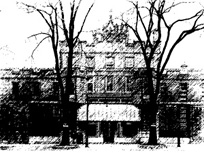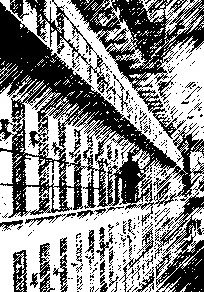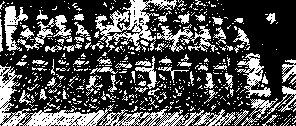|
On the Penitentiary System in the United States and Its Application in France By Gustave de Beaumont & Alexis de Tocqueville The principle of corporal punishment.
We have noticed the remarkable differences which exist in the disciplinary order of the various establishments. All, however, admit the principle of corporal punishment; and it is just to say, that there exist in the particular situation of each of the prisons, certain circumstances, which tend to explain the mildness or severity of its discipline. If we remember the nature of the labors executed at Sing Sing, and the order established in that prison, we easily understand the insurmountable obstacles with which disciplinary order would meet in this prison, were it not supported by the most energetic measures of repression. Auburn does not require so much severity, because the same dangers do not threaten the order of the establishment. Wethersfield is, in this respect, in a still more favorable position; it contains less than two hundred criminals, while Auburn has six hundred and fifty, and Sing Sing more than nine hundred. It is evident, that the number, more or less considerable, of criminals, and the nature of the labor, render the penitentiary more or less easy of government.
Now, could these various penitentiaries dispense with corporal chastisement? This is a question which we dare not solve. We are merely able to say, that, deprived of this assistance, prison discipline would meet with difficulties very difficult to be overcome. Its embarrassments would be so much the greater, as it is founded on an unique basis, that of absolute silence; and should it ever be deprived of this foundation, the whole fabric must inevitably crumble to pieces; now, how is it possible to maintain absolute silence among criminals, if they are not continually overawed by the fear of a prompt and rigorous chastisement? In the American prisons, this discipline, founded upon stripes, is so much more powerful, as it is practiced more arbitrarily. At Sing Sing, and at Auburn, there are no written regulations: the superintendents of these prisons, have only, in their government, to conform themselves to the verbal prescriptions which they receive from the inspectors, and to a few principles expressed in the law. These principles are: solitary imprisonment of the convicts during night, and labor in silence during day. For the rest, they enjoy, as to all acts of execution, a discretionary power. At Sing Sing, the superintendent has even the right to delegate this discretionary power to all his inferior agents; and in fact he has transmitted his power to thirty jailors, who are invested like himself with the power of chastising the convicts. At Auburn, the superintendent alone has the power to punish; yet the same authority belongs to the inferior keepers, in all cases of urgent and absolute necessity. The same is the case in Boston. In Wethersfield, the regulations of the prison are in writing. The subaltern officers can in no case exercise the right of punishing, with which the superintendent alone is invested, and which he uses with so much moderation. Important debates have taken place in the state of New York, on the question whether the presence of an inspector ought to be required when inflicting stripes upon a prisoner. According to the letter of the law, this guaranty was indispensable, but the obligation of the inspectors to be present at such punis hments, was so frequently inconvenient, and caused them such painful feelings, that they asked immediately to be absolved from this duty. At present the right of the officers to inflict stripes without these official witnesses is acknowledged. The inspectors have nevertheless a great influence on the application of disciplinary chastisement. Shackled in irons, they were transported in 1825 by boat via the Erie Canal and the Hudson to the chosen site, an abandoned mine in a village whose name derived from the area's original native tribe, the Sint Sinck. On April 2, 1813, the community of Sing Sing, then a part of Mount Pleasant, had become the first village in Westchester to be incorporated. Sing Sing is the only prison where their superintendence has appeared to us superficial upon this point. The administration of this vast penitentiary is so difficult, that there seems to be no disposition to dispute the least part of the absolute power of the keepers. . . .
To what point are corporal chastisements, reconcilable with the object of the penitentiary system itself, which is the reformation of the guilty? If this pain be ignominious, does it not go directly against the end which we propose to obtain, viz. to awaken the morality of an individual, fallen in his own opinion? . . . The punishment of stripes is in use in the American navy, with no idea of infamy attached to it. In the beginning, the whip was not admitted as a disciplinary means in the penitentiary system. When it was introduced as an auxiliary to the regulations, some voices were raised against it, but this opposition was much more a dispute of philosophy than one of repugnance to the national customs. Pennsylvania is, perhaps, the only state in the Union which continues to protest against corporal punishment, and which excluded it from the regulations of her prisons. The Quakers cease not to protest against the inhumanity of this punishment, and their philanthropic protestations are joined by the eloquent voice of Edward Livingston, who also rejects this means of discipline from his code. It is chiefly on account of corporal punishment, made use of at Auburn, that he declares himself the adversary of the system which is in practice in that prison. But their words find few corresponding voices in most parts of the Union, and, at present, all new penitentiaries, that of Philadelphia only excepted, make use of the whip. The laws of the country authorize the discipline which they have adopted, and these laws have the sanction of public opinion. There is certainly much exaggeration in the reproaches made against the Auburn discipline. First, stripes are not so frequent as is believed. Necessary, as they are, to establish silence in a newly founded prison, the are seldom made use of in order to maintain this regulation if once established. Now, is the whole system of these prisons, as is asserted, injurious to health, and are the rigors of solitude and the cruelties of the discipline, fatal to the life of the imprisoned? We are able to furnish positive documents upon this point.
All prisoners, whom we have seen in the penitentiaries of the United States, had the appearance of strength and health; and if we compare the number of those who die there with the mortality in the old prisons, we shall see that the new penitentiaries, in spite of their severe regulations and barbarous discipline, are much more favorable to the life of the imprisoned. Mr. Edward Livingston wishes to see solitary confinement during night and day, without labor, and reduction of food substituted for the whip, as a disciplinary measure. It does not seem that at Wethersfield this punishment, which as we have seen, is preferred to stripes, has produced bad effects. However, ten individuals are mentioned as having died in consequence of this kind of punishment in the prison of Lamberton in New Jersey, while there is no case yet on record of a prisoner having become the victim of corporal whipping. In the old Walnut street prison, there was formerly, during each year, one death out of sixteen prisoners, and in that of New York (Newgate) one out of nineteen. In both these prisons, the criminals were neither in solitary confinement, nor obliged to be wholly silent, nor subjected to corporal punishment. In the new penitentiaries, founded upon the principles of silence and isolation supported by the discipline of stripes, death takes place in an infinitely smaller proportion. At Sing Sing, one prisoner died out of thirty-seven; at Wethersfield one of forty- four; at Baltimore one of forty-nine; at Auburn one of fifty-six; and at Boston one of fifty-eight. Still more: if we compare the mortality of the prisoners to that of persons enjoying liberty and society, we shall yet arrive at a result favorable to the penitentiaries. There dies, in fact, in Pennsylvania, every year, one out of thirty-nine persons, and in Maryland one out of forty-seven. Again, in the old prisons where free communication existed, and where the discipline was mild, one half more died than in society generally. And in the new penitentiaries, subject to the austere system of isolation, silence, and stripes, deaths are less numerous. These ciphers are better answers than all possible arguments, to the objection which have been raised. We have said nothing on the sanitary state of the new Philadelphia prison, which has been in existence for too short a time to judge fully of its effects. We have every reason to believe that the system of perpetual and absolute seclusion, established there in full vigor, will prove less favorable to the health of the prisoners than the Auburn system. Yet the physician of that establishment believes himself able already to declare that the mortality will be less there than in the ancient prison of Walnut street. To sum up the whole on this point, it must be acknowledged that the penitentiary system in America is severe. While society in the United States gives the example of the most extended liberty, the prisons of the same country offer the spectacle of the most complete despotism. The citizens subject to the law are protected by it; they only cease to be free when they become wicked. |





